Lucky Me Chow Mien Spicy Beef
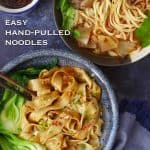

A complete guide to Chinese paw-pulled noodles. Techniques explained in detail and two shapes introduced. Following this recipe, everyone can brand them with ease!
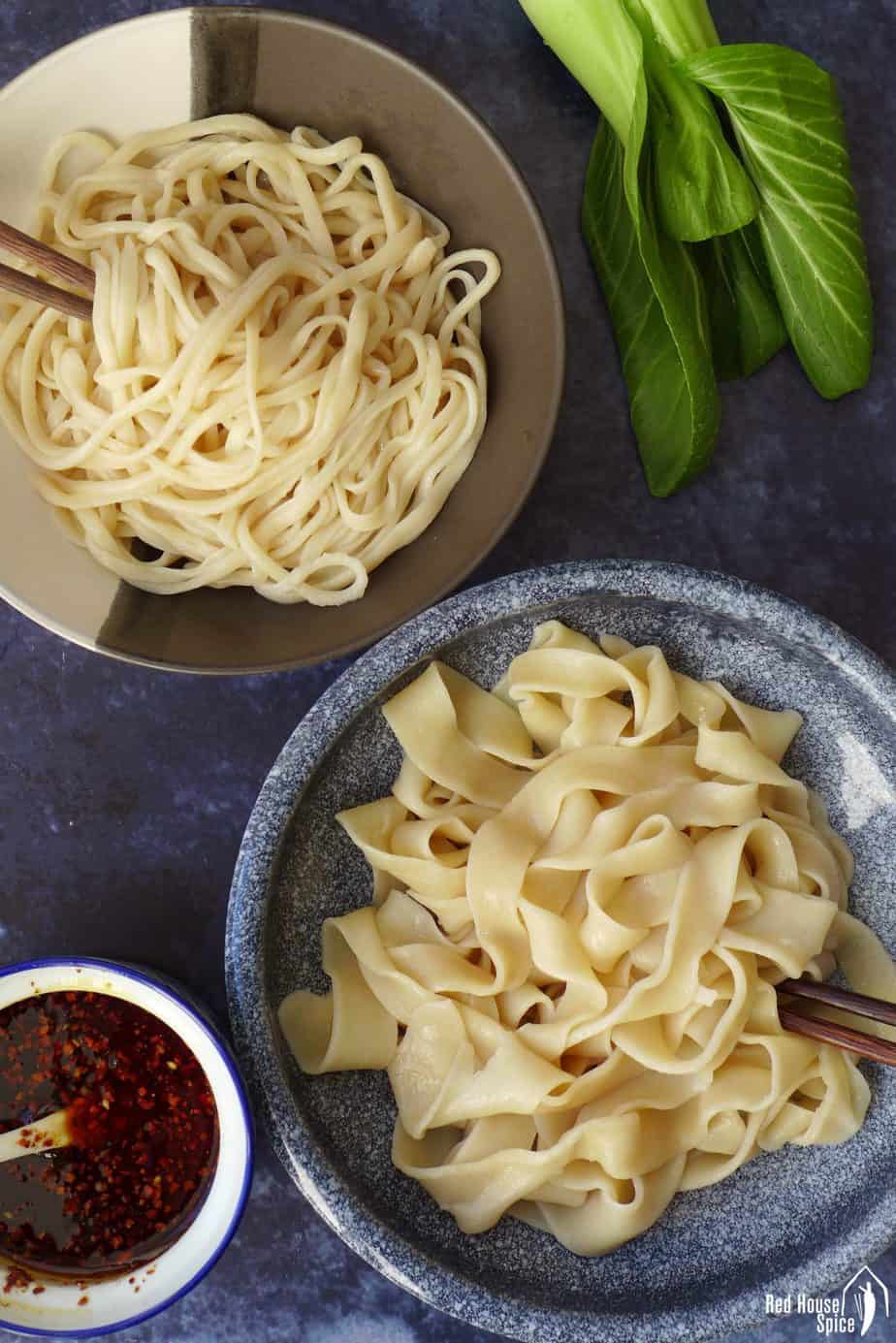
Hand-pulled noodles, known as Lā Miàn/拉面, Lā Tiáo Zi/拉条子 or Chě Miàn/扯面, is a recipe that I've been significant to share for a long time. Growing up in Gansu province, China where information technology's a mutual dish in restaurants and households, I learned the technique through observing my parents' cooking. I enjoy the pleasure of both making and eating them.
What are hand-pulled noodles
As its name suggests, hand-pulled noodles are formed past pulling wheat flour dough by hand into long, elastic strips. Compared to hand-cutting and machine-made noodles, they normally have a more silky, springy and chewy texture. They are ever served super fresh as the pulling and cooking process happens at the same time.
What are they made of?
Manus-pulled noodles contain three basic ingredients: wheat flour, common salt and water. In some cases, an alkaline agent is added to the dough to make the noodles more springy.
Two types of paw-pulled noodles
The professional person version
Ane serving of noodles are pulled from one single slice of dough by folding multiple times. Lanzhou Beefiness Noodle Soup/兰州牛肉面 (aka Lanzhou Lā Miàn, 兰州拉面), the archetype dish of my hometown, showcases this amazing culinary art of noodle making. The employ of an alkaline agent (Péng Huī/蓬灰 in this instance) makes the dough super flexible and stretchy.
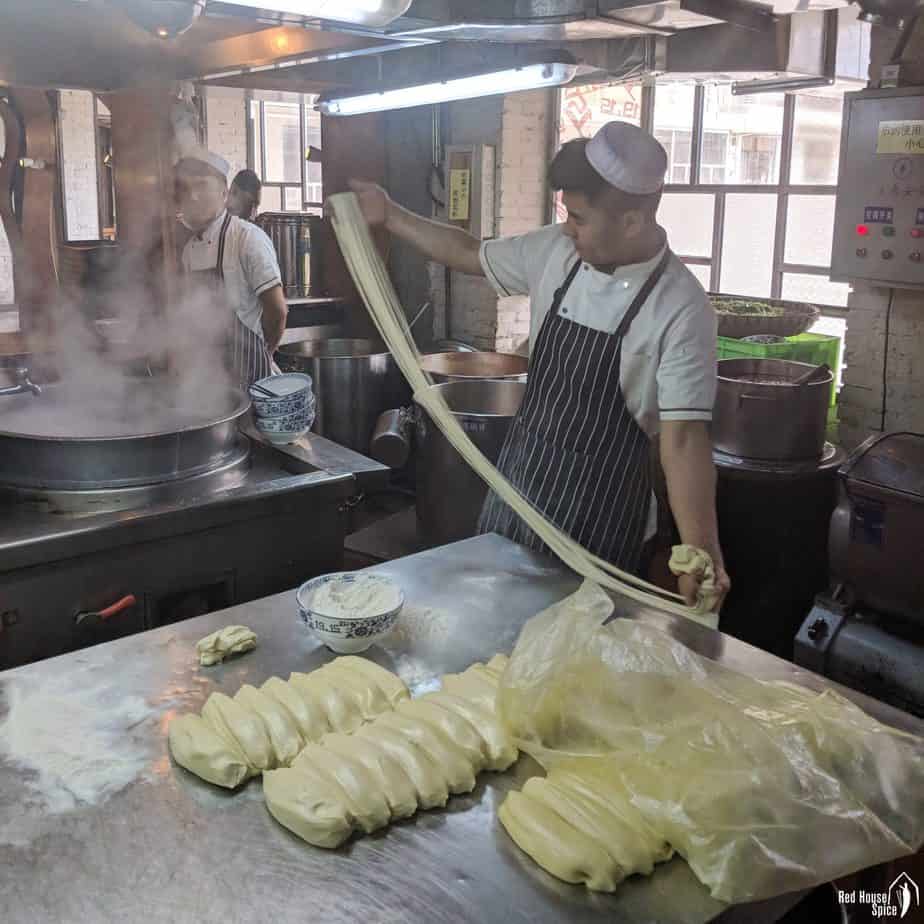
If yous haven't seen how they are made, I suggest you have a look at a noodle pulling video I took on one of my Culinary Tours of Red china. My tour participants were very lucky to have the chance to visit the dorsum kitchen and communicate with the chefs. On my next tours, we will go i step further to put our hands on the dough and learn from professional noodle masters.
The easy home version
My recipe introduces another type of hand-pulled noodles: the dough is firstly cut into strips then pulled i past one into long noodles. The popular Eleven'an Biang Biang Noodles are made this manner.
Compared to the professional method, this technique is much easier to chief. Although unproblematic to brand, I'd like to explicate in item every aspect of this dish. I hope my complete guide will assistance you, including kitchen novices, to have a fail-proof experience learning this cooking skill.
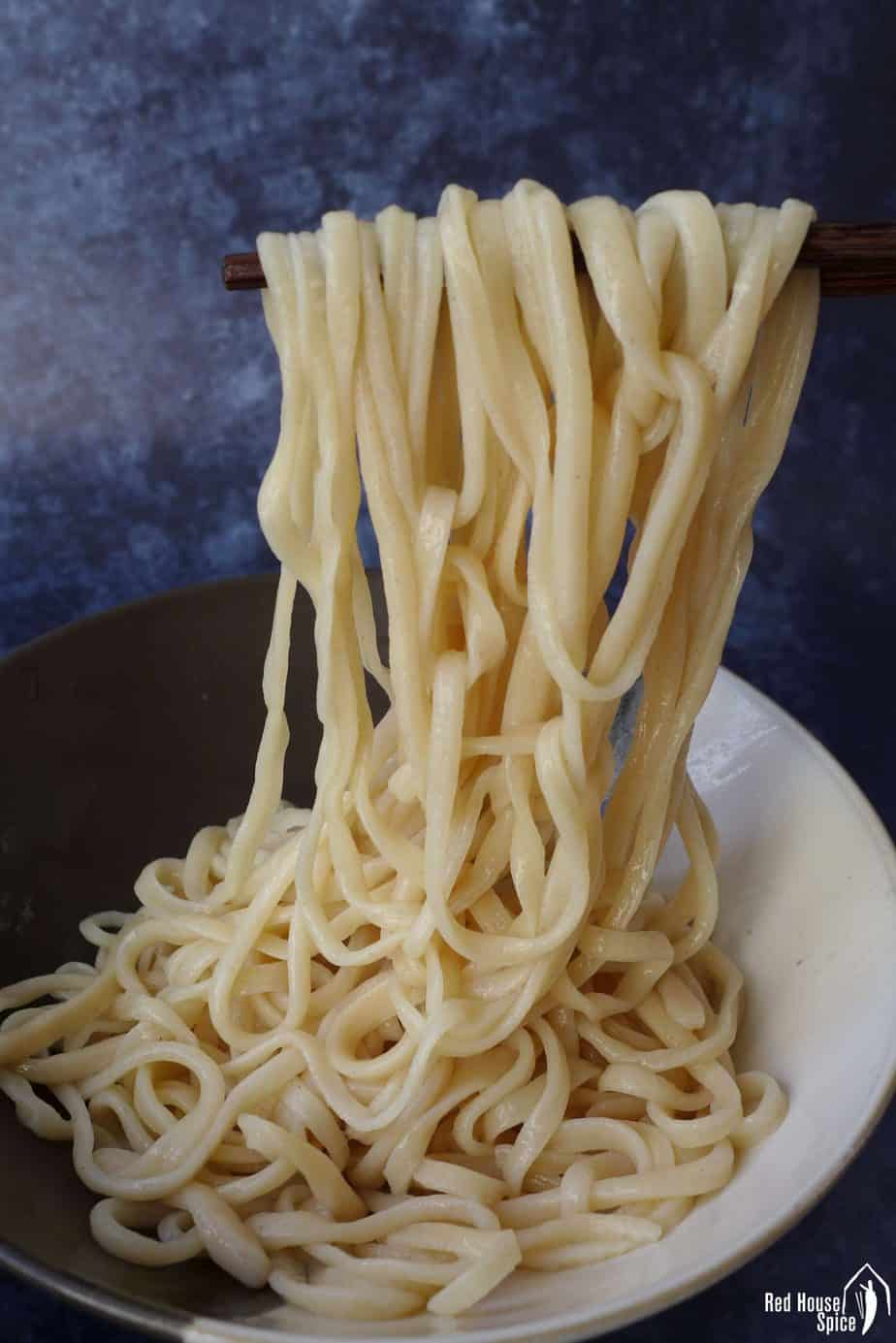
The bones workflow
Before we go downwardly to the detailed explanations, let me first outline the procedures for making hand-pulled noodles.
- Make a smooth, fairly firm dough using flour, salt & water.
- Split and so flatten the dough. Coat with oil and so exit to residue.
- Bring a pot of h2o to boil. Cut the dough pieces into strips.
- Pull the strips into long noodles i at a time. Drop into the water.
- Cook for i-ii minutes then dish out.
How to make the perfect dough
The dough for mitt-pulled noodles involves three basic ingredients: wheat flour, water and a trivial salt. The finished dough should exist soft, smoothen and elastic thus can be easily pulled into the desired shapes without breaking. Paying attention to the following rules, everyone tin brand perfect dough with ease.
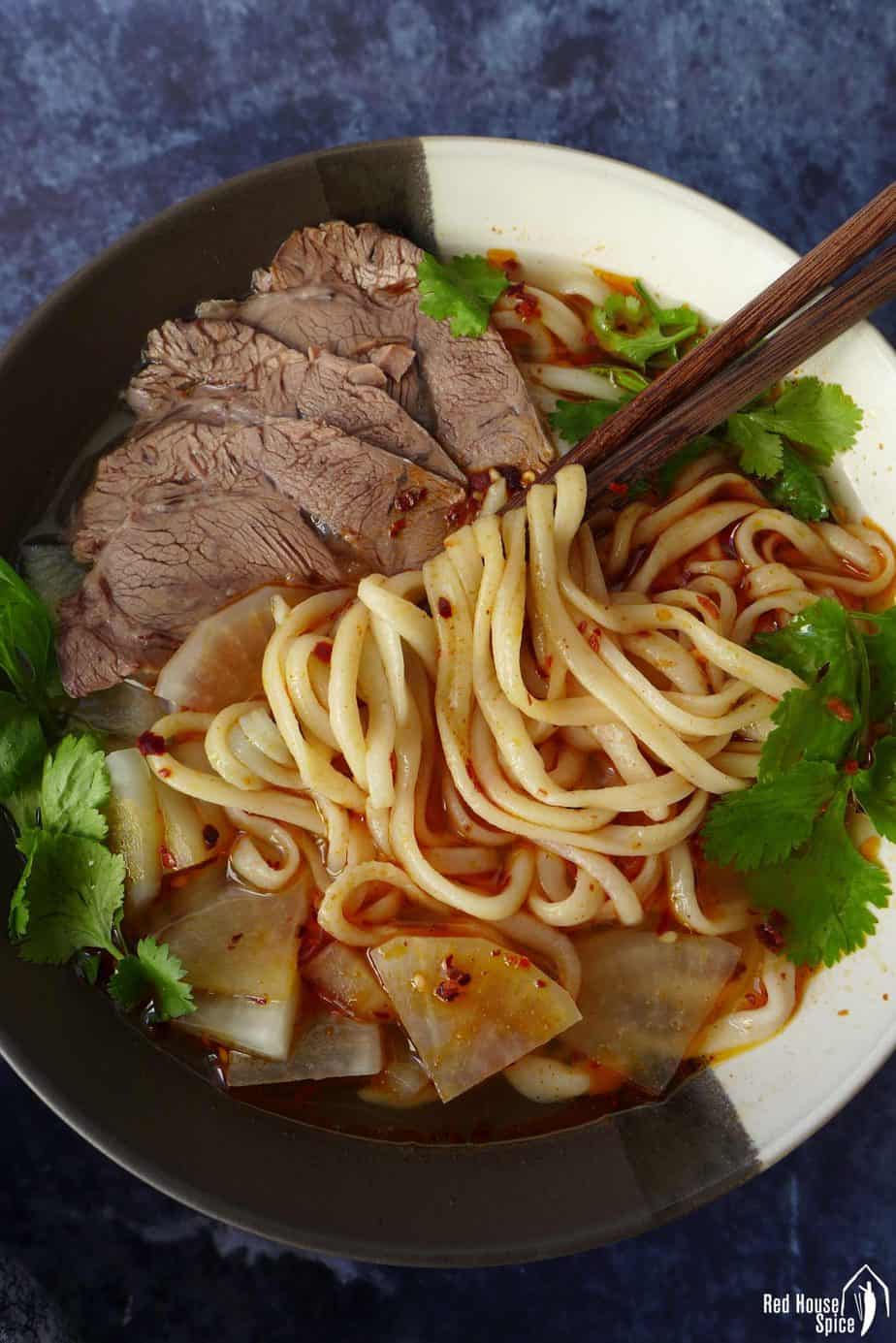
Apply all-purpose flour with medium gluten
Flour with a medium level of gluten works the best for hand-pulled noodles. That is to say that the poly peptide content should be x-11g per 100g flour. All-purpose flour (aka plain white flour) sold in the US and the United kingdom falls into this range.
All the same, the gluten level of all-purpose flour varies among countries. Check the nutrition characterization on the package to learn the protein content.
Flour high in gluten (above 13g protein per 100g flour), such as very strong bread flour, can be used for this recipe but it's harder to work on. Due to its potent, super elastic gluten, the dough tends to shrink back and breaks more than easily when pulled.
NB: Wholemeal flour/gluten-free flour is not suitable for making hand-pulled noodles.
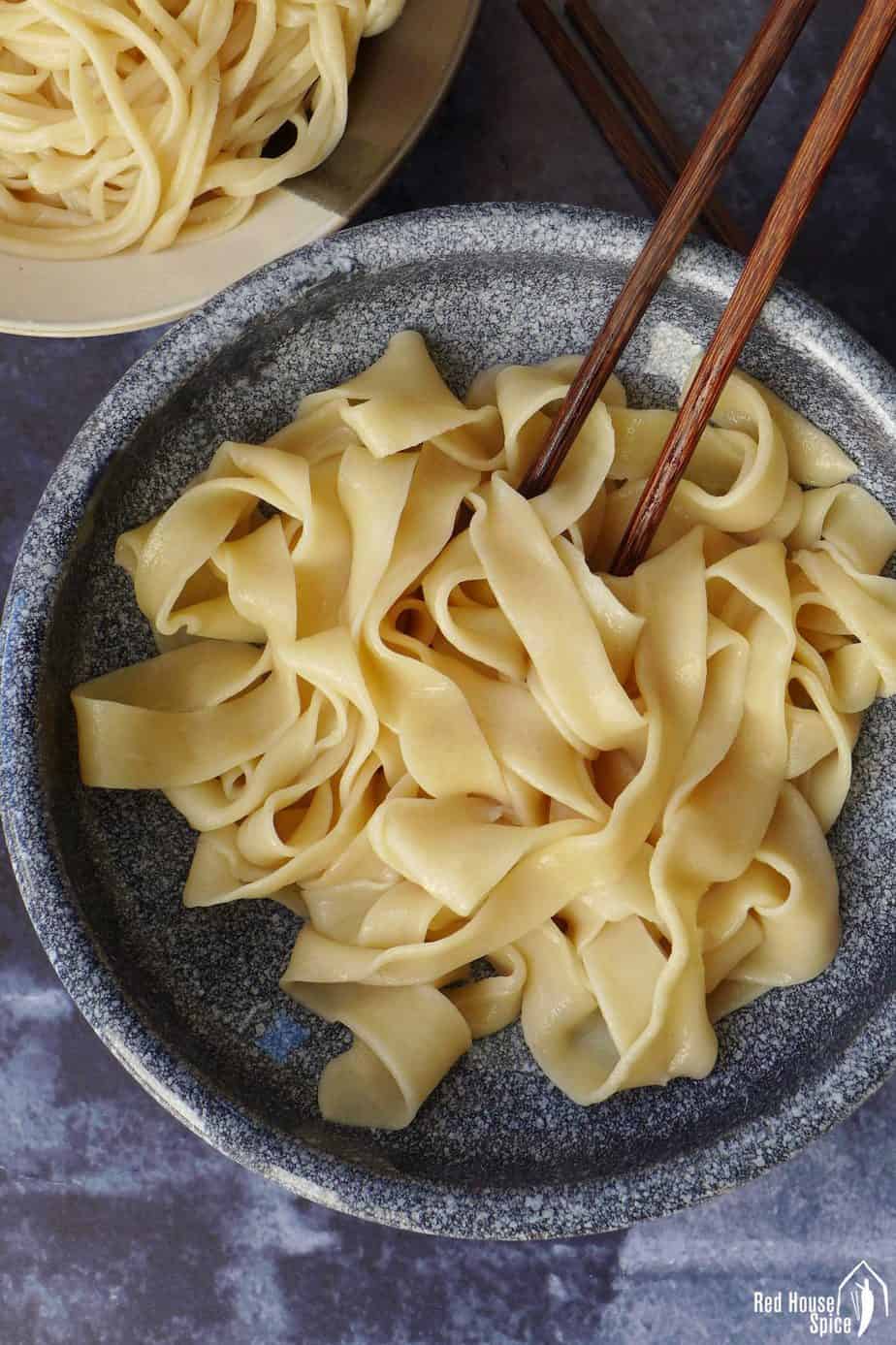
The flour-h2o ratio is 2:1 by weight
To ensure a fail-proof experience, I recommend you measure flour past weight every bit it's much more accurate than measuring with a cup.
The flour-water ratio is 2:one past weight. In my recipe, I add 125g/ml h2o to 250g flour to brand a dough for ii servings.
You might demand to slightly accommodate the water book as flour of different brands absorbs water differently. The initial dough (before resting) should be smooth just quite firm. You wouldn't need to dust the piece of work surface with flour when kneading/rolling.
Add a little salt to the dough
Just like my parents always exercise, I add a little table salt to the dough for paw-pulled noodles. This is to make cooked noodles more than "Jīn Dào, 筋道" meaning "Al Dente".
In "On Food and Cooking", scientist Harold Mcgee explains the purpose of calculation common salt to noodles: "Information technology tightens the gluten network and stabilizes the starch granules, keeping them intact fifty-fifty as they absorb water and swell."
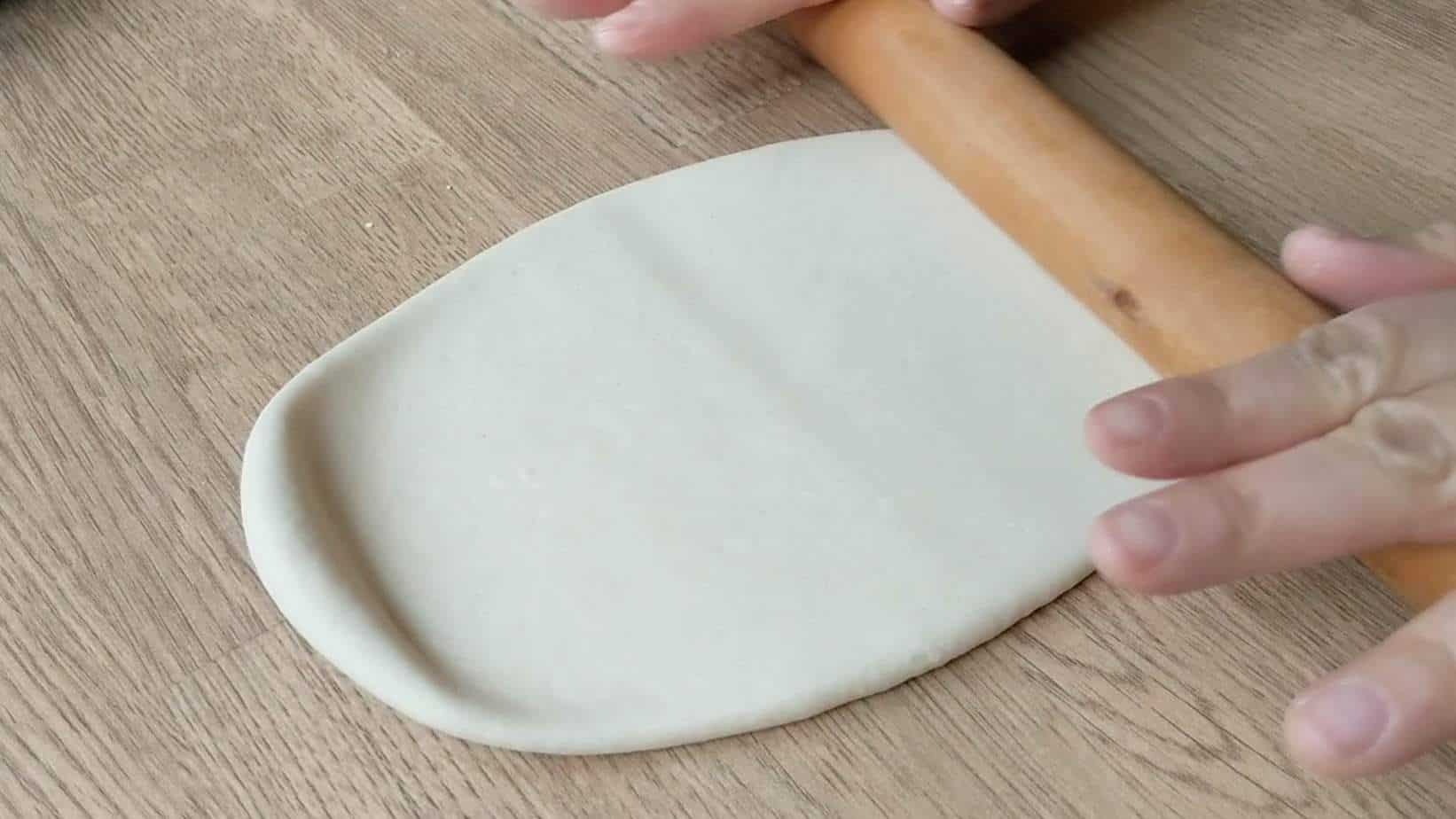
Glaze the dough with oil thoroughly
After the dough has been formed, you need to do the following before leaving it to rest:
- Cut the dough into sections. If you are making 2 servings, and then cut it into ii pieces.
- With a rolling pin, flatten each piece to about ½ cm in thickness.
- Coat each piece with cooking oil thoroughly (both sides). Identify them one on elevation of another in a tray. Cover with clingfilm.
Coating with oil is a crucial process. It prevents the dough pieces from sticking to each other. It likewise helps the final noodles to gain a shine, silky look.
Some people coat the dough with flour instead. This also works but the cooked noodles tend to have a rougher advent and a stickier texture on the surface.

Allow plenty time to residuum the dough
When it comes to dough training, resting is very important and can non be skipped. As I mentioned above, the initially formed dough is quite firm. Over time, the elasticity of the dough relaxes. It becomes softer and more malleable. This process makes noodle pulling then much easier!
I recommend yous rest the flattened dough pieces for at least 1.v hours. If you fix the dough in advance and pull it the next day, you can store it in the fridge. But, remember to allow it to come back to room temperature before you start working on it.
How to pull the noodles
Here comes the most exciting part (probably the about intimidating too): Pull the noodles with your hands. Unlike the primary chefs in Lanzhou beef noodle restaurants, Chinese home cooks, like my parents, pull their noodles one strip at a time. My foolproof recipe uses the same method.
First of all, you need to cutting the flattened dough pieces into strips. Be gentle when y'all transfer them onto the work surface equally they've become very soft after resting. Try to retain their shape and do not compression or pull (still!).
Round or flat? Choose the noodle size
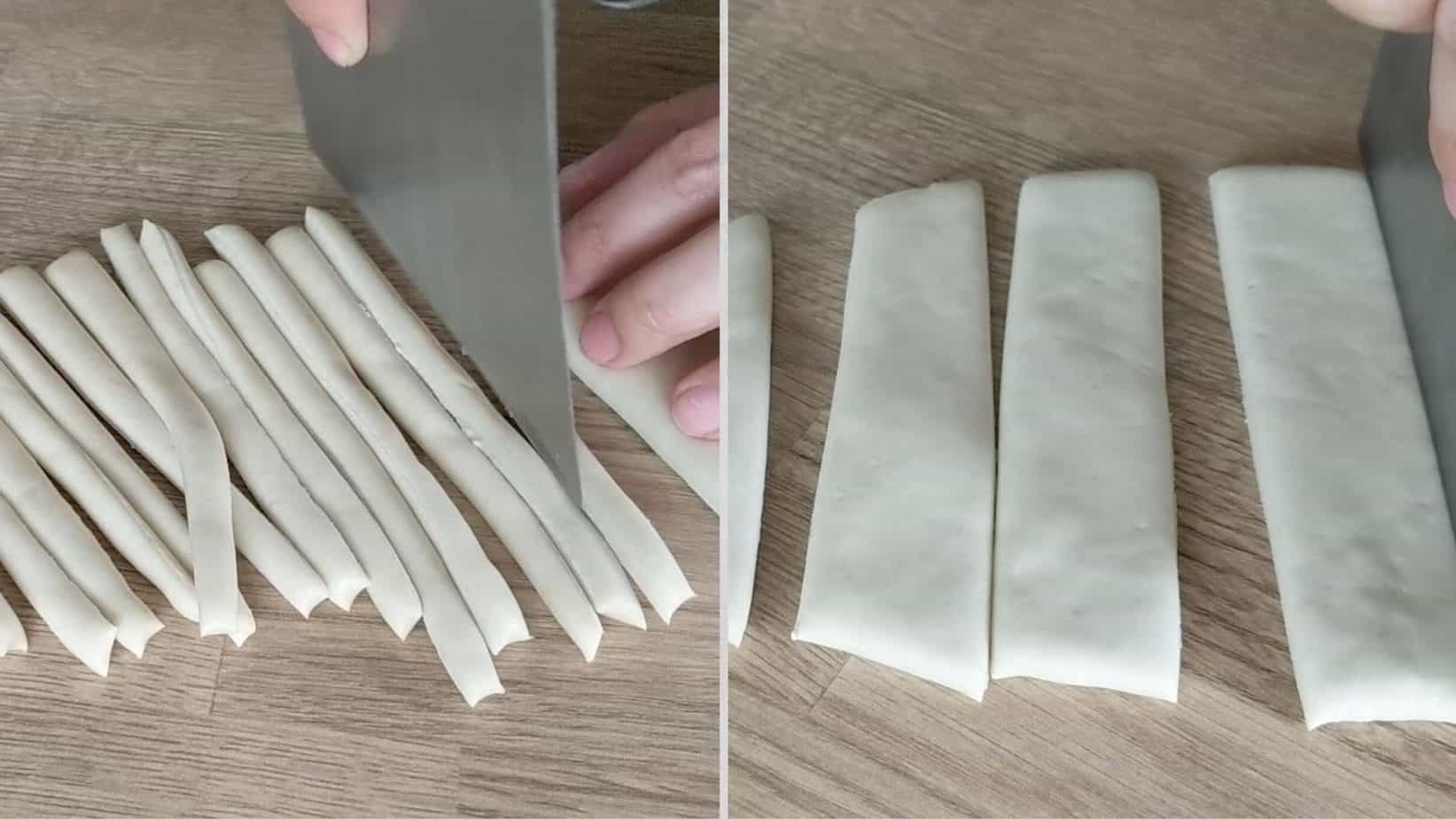
Do yous accept a preference for the shape of the noodles? Round, thin ones or apartment broad ones? I love both. So my recipe includes ii ways of shaping the noodles. Give both a try to see what works and tastes better for yous.
- Circular, thin noodles: Cutting the flatten dough into sparse strips, about 1 cm broad.
- Apartment, wide noodles: Cut the flatten dough into wide strips, nearly 3 cm wide.
Noodle pulling technique
- Pick upward ane strip of dough by holding each cease gently.
- Pull towards opposite directions. The motion should be smooth and consistent..
- As your artillery motility autonomously, bounce the noodle confronting the worktop to assist it stretch further. Fold the noodle and repeat the movement.
Please check out my tutorial video (to a higher place in the post & below in the recipe card)to see exactly how I do information technology.
An alternative method
If you discover the technique above difficult to main, endeavour the alternative method: Over a pot of boiling water, concord one end of a strip of dough and pull the other end towards the h2o. Drop the pulled part into the water and continue pulling the remaining part (Please refer to the video).
How to melt the noodles
Compared to other types of noodles, the dough for hand-pulled noodles has a very high h2o content thus it's very soft, easy to stick and tin can be cooked through fairly chop-chop.When cooking them, you need to take this feature into account. Here are some full general rules to follow:
Melt i serving at a time
Pulling and cooking happen at the aforementioned fourth dimension. Drop one pulled noodle straight into the boiling water so work on the side by side one. Stop when yous finish all the dough strips for ane serving.
Do not overcook
It takes quite a short time to cook hand-pulled noodles. If making circular, narrow ones, get out to melt for 1 minute. If making flat, broad ones, go out to cook for 2 minutes. Do not overcook. Perfectly cooked noodles should be shine, silky in advent and quite chewy in texture.
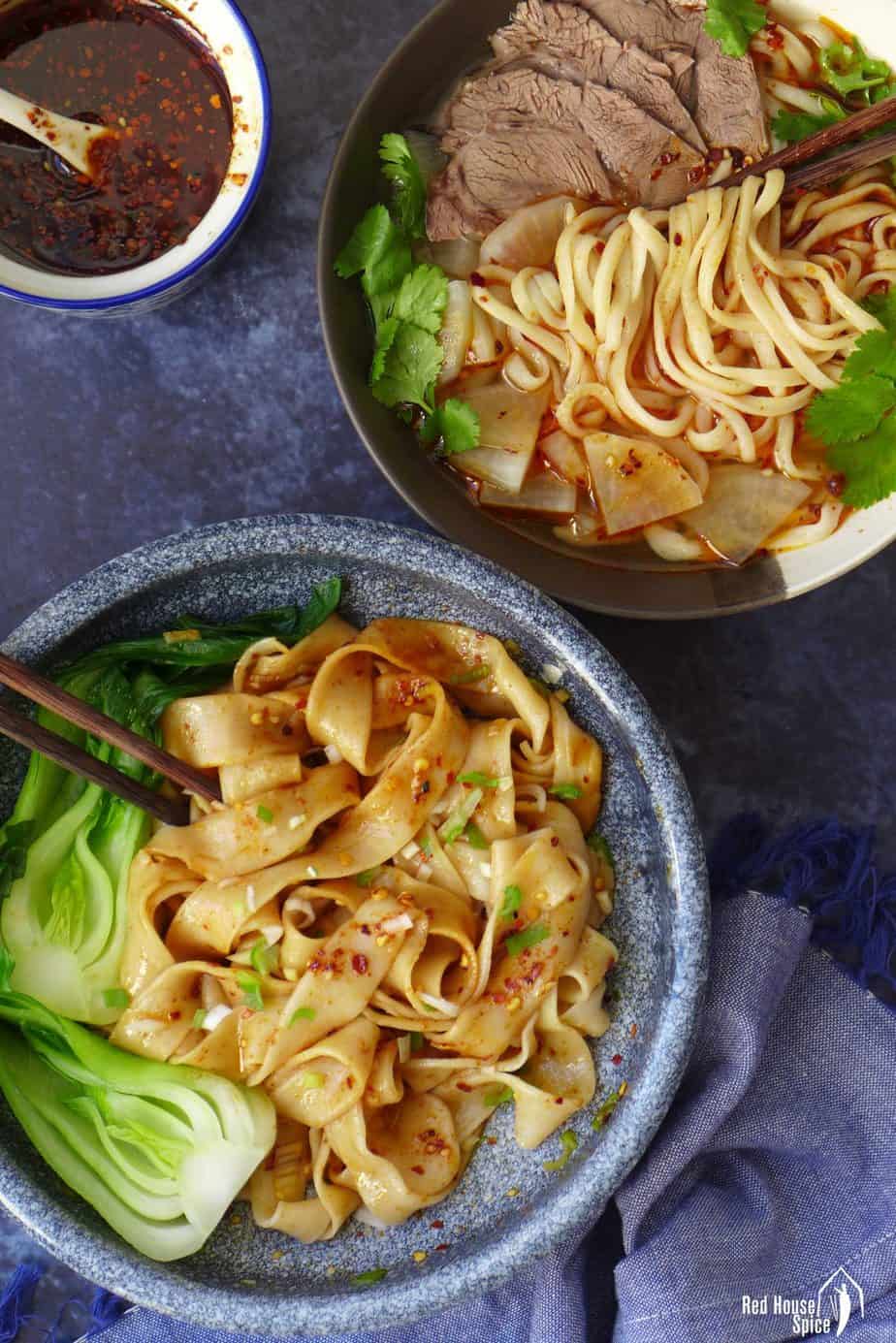
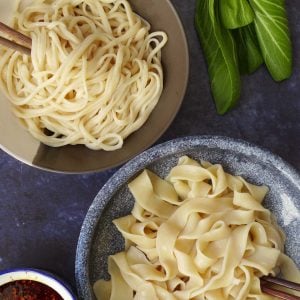
- 250 g all-purpose flour, virtually ii cups (run into note 1)
- ¼ teaspoon salt
- 125 ml water, ½ cup + 1 teaspoon
- cooking oil, for coating the dough
Prepare the dough
-
IF KNEADING Past HAND: Mix flour and salt. Add together h2o gradually. Mix with chopsticks/spatula until no more loose flour can be seen. Combine and knead briefly into a dough. Go out to residue for 10-15 minutes (covered). Knead again for about 2 minutes until very polish.
-
IF KNEADING WITH A STAND MIXER: Add flour, common salt and h2o into the mixing basin. Knead on low speed until a very smooth dough forms.
Coat & rest the dough
-
Split the dough into two equal parts. With a rolling pivot, flatten each piece into a rectangle shape (about ½ cm thick).
-
Thoroughly coat each slice with oil then identify them on a tray. Cover with cling flick then go out to rest for one.5 hours.
Cut the dough
-
Bring a large pot of water to a full boil. While waiting, cutting the dough.
-
Place one slice of dough on a chopping board. Widthways, cut information technology into strips: about i cm wide if making circular, sparse noodles; about 3 cm wide if making apartment, wide noodles.
Pull the noodles (come across note 3 for alternative method)
-
Pick up ane strip of dough past belongings each finish gently. Pull towards opposite directions. The movement should exist smoothen and consistent.
-
As your artillery movement autonomously, bounce the noodle against the worktop to help it stretch further.
-
Fold the noodle and echo the move (Please refer to the video beneath).
Cook the noodles
-
Drop the pulled noodle into boiling water. Echo the procedure to pull other strips cutting from the commencement piece of dough.
-
Cook 1 infinitesimal for the thin noodles or ii minutes for the broad noodles (While waiting, cutting the second piece of dough into strips.). Transfer the noodles to a serving bowl using a pair of chopsticks.
-
Repeat to pull and cook the second bowl of noodles.
Serve the noodles
-
To avoid the noodles sticking to each other, serve immediately.
-
You may add a goop or mix the noodles with toppings/dressings. Please see note 4 for recipe links.
Store & Reheat
-
If not serving straight away, yous demand to briefly rinse the noodles with cold water and so add a few drops of sesame oil and stir well. Proceed in the fridge for up to ii days.
-
To reheat: Bring a pot of water to a full boil. Add the noodles and melt for no more than xxx seconds.
i. Please be aware that measuring flour by cups is less accurate and the flour-water ratio may vary depending on the brand of your flour. Adjust appropriately. The finished dough should be medium-firm and smooth.
two. You can shop the dough in the fridge for next twenty-four hours use. Later on taking out of the refrigerator, brand sure you allow enough time for the dough to get dorsum to room temperature before pulling.
3. Culling Pulling Method: Over the boiling h2o, concord 1 end of a strip of dough and pull the other end towards the h2o. Drop the pulled part into the water and continue pulling the remaining part (Please refer to the video higher up).
iv. You can use hand-pulled noodles for the post-obit dishes:
- Lanzhou Beef Noodle Soup
- Zha Jiang Mian
- Eleven'an Biang Biang Noodles
- Spicy Beef Noodle Soup
- Noodles with Tomato & Egg Topping
- Craven Meatball Noodle Soup
Serving: one serving | Calories: 455 kcal
Show me your dish or ask me questions @red.house.spice
Reader Interactions
williamsriefterin.blogspot.com
Source: https://redhousespice.com/hand-pulled-noodles/
0 Response to "Lucky Me Chow Mien Spicy Beef"
Post a Comment